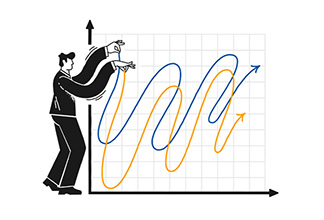5 Ways to Get More Out of Your RESP
Written by The Inspired Investor Team
Published on July 11, 2025
minute read
Share:
In September, parents across the country will be sending their children off to university, some for the first time. To pay for school, many Canadians will tap into the Registered Education Savings Plans (RESPs) they’ve been using to save for post-secondary education. For those with younger children who may be at the beginning of their education savings journey, here are some ways you can make the most of this investment vehicle.
1. Starting early and making regular contributions
Few registered accounts stretch a dollar as far as the RESP. This investment vehicle allows you to grow money tax-free until those funds are withdrawn, while government grants pitch in what’s essentially free money to boost your savings even further. To take advantage of all the RESP has to offer, you might want to consider starting to save as early as you can.
To open an RESP account, you need your child’s social insurance number (SIN) – if they don’t have one yet, you can apply for one via Service Canada. Opening this account as soon as possible – even if you can only contribute a little bit or you can’t contribute regularly – could position you to claim every available government grant you qualify for. It also means you have nearly two decades to work toward the lifetime contribution ceiling of $50,000 per child, as well as giving compound growth more time to work its magic.
If you have (or plan to have) more than one kid, you could open a family RESP, which lets you pool contributions and grants1 for all siblings and, later, redirect any unused money to the child who needs it most.
2. Maximizing government grants
The Canada Education Savings Grant (CESG) is one of the main benefits of using an RESP. The Canadian government will match 20 per cent of your annual contribution up to a maximum of $500 (20 per cent of a $2,500 contribution) and a lifetime ceiling of $7,200 per child. The grant is available up until the end of the calendar year in which the child turns 17, although specific contribution requirements apply at ages 16 and 17.
To reach the maximum grant amount, you could put $2,500 into the RESP every year up until the child is 17. Not only does that ensure you’ll get the full amount of grant money possible, but those dollars can start growing right away.
If you’ve opened an RESP later, or haven’t contributed right away, you can catch up by doubling that year’s deposit to $5,000, which will give you $1,000 in grant money. However, you can only reclaim one previous year per calendar year. If you have missed several years, it might take a few $5,000 contributions to get the full amount of CESG that the beneficiary is eligible to receive. Low‑ and middle‑income families (based on net family income) can also qualify for an additional CESG top‑up of up to $100 on the first $500 contributed.
There are also provincial grants available, such as the BC Training and Education Savings Grant (BCTESG) and the Quebec Education Savings Incentive (QESI).
You can visit the Canada Revenue Agency (CRA) and provincial websites to learn more about the qualification requirements for various grants.
3. See if you qualify for the Canada Learning Bond
The Canadian government also provides an additional incentive of up to $2,000 in funding to help low-income families. To qualify for the Canada Learning Bond (CLB), a child must have been born on or after January 1, 2004, be a resident of Canada and have a valid SIN. If your family falls within the program’s income thresholds, the government will add $500 to your child’s RESP when the account is opened, and an additional $100 every year until they turn 15 or the $2,000 maximum is reached. You don’t need to make contributions to access this funding, but your child must be designated as a beneficiary of an RESP account to receive it.
4. Getting family to chip in
Another advantage to the RESP is that anyone – grandparents, aunts, uncles or family friends –can deposit money into the account. That means it doesn’t have to be all up to you to contribute. All contributions, whether they’re directly deposited into the account or given as a birthday cheque that you transfer in yourself, are eligible for the CESG top‑up while also helping bring your child’s plan closer to the $50,000 lifetime contribution ceiling.
If a family member wants to take it a step further, they can open an RESP account for your child on their own and contribute to it regularly. In fact, there is no limit to the number of accounts that can be opened in a person’s name – just remember that the lifetime limit for grants and contributions applies to all accounts together. If the collective amount of deposits exceeds $50,000, a tax of 1 per cent per month2 will be charged on the excess amount.
5. Automating your contribution
One way to help ensure you contribute the maximum $2,500 per year to your child’s RESP is to set up an automatic monthly, semi-monthly or quarterly transfer from your chequing account. That will get you to the CESG contribution limit and unlock the full $500 Canadian government grant each year.
As the new school year approaches, it’s a good time to revisit your RESP plans – even if your child is still years away from university. Assess your asset allocation and adjust if needed, find ways to maximize your contributions and make sure the rest of your family knows they can help send your kid to college, too.
Sources
1. Government of Canada, "Open a Registered Education Savings Plan and apply for benefits", November 2024
2. Government of Canada, "Managing the Registered Education Savings Plan, taxes and transfers", June 2024
RBC Direct Investing Inc. and Royal Bank of Canada are separate corporate entities which are affiliated. RBC Direct Investing Inc. is a wholly owned subsidiary of Royal Bank of Canada and is a Member of the Canadian Investment Regulatory Organization and the Canadian Investor Protection Fund. Royal Bank of Canada and certain of its issuers are related to RBC Direct Investing Inc. RBC Direct Investing Inc. does not provide investment advice or recommendations regarding the purchase or sale of any securities. Investors are responsible for their own investment decisions. RBC Direct Investing is a business name used by RBC Direct Investing Inc. ® / ™ Trademark(s) of Royal Bank of Canada. RBC and Royal Bank are registered trademarks of Royal Bank of Canada. Used under licence.
© Royal Bank of Canada 2025.
Any information, opinions or views provided in this document, including hyperlinks to the RBC Direct Investing Inc. website or the websites of its affiliates or third parties, are for your general information only, and are not intended to provide legal, investment, financial, accounting, tax or other professional advice. While information presented is believed to be factual and current, its accuracy is not guaranteed and it should not be regarded as a complete analysis of the subjects discussed. All expressions of opinion reflect the judgment of the author(s) as of the date of publication and are subject to change. No endorsement of any third parties or their advice, opinions, information, products or services is expressly given or implied by RBC Direct Investing Inc. or its affiliates. You should consult with your advisor before taking any action based upon the information contained in this document.
Furthermore, the products, services and securities referred to in this publication are only available in Canada and other jurisdictions where they may be legally offered for sale. Information available on the RBC Direct Investing website is intended for access by residents of Canada only, and should not be accessed from any jurisdiction outside Canada.
Explore More

There's an ETF for That!
Find out more about the options that are out there
minute read

ETF Trends from the RBC Capital Markets Trading Floor – May 2025
Here’s what we saw on the trading floor in May 2025
minute read

Why Order Types Matter During Market Volatility
When markets swing, how you place a trade can make a difference
minute read
Inspired Investor brings you personal stories, timely information and expert insights to empower your investment decisions. Visit About Us to find out more.







